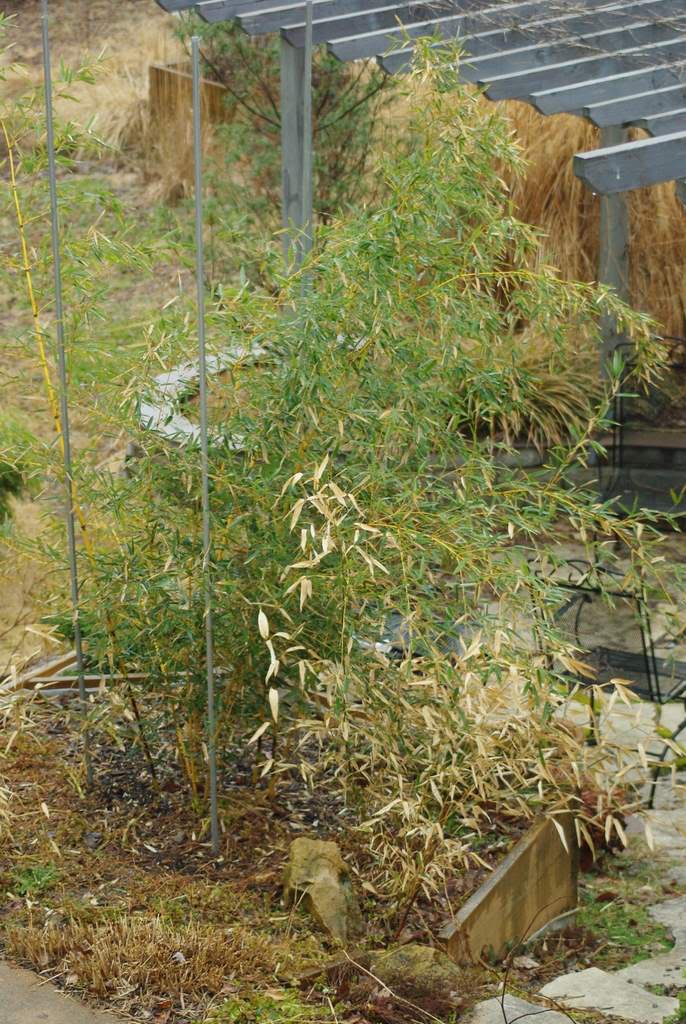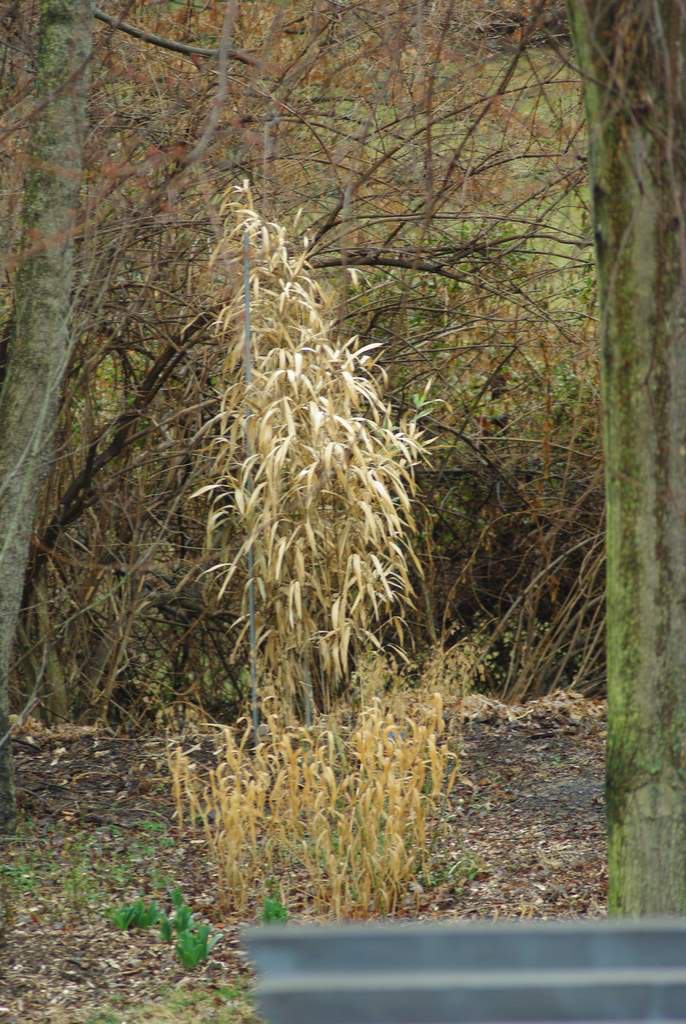That's Semiarundinaria okuboi, looking pretty much fried, even though it was wrapped in plastic for wind protection. There are a few green leaves left in there.
***
The result of this extra-frigid winter is that my bamboos suffered more damage than they did last winter, which was the first one for my bamboos. I wrapped a few of the less cold-hardy plants in plastic to give them wind protection. Cold, dry wind is bad for bamboo (and other evergreen plants) in that it really sucks the moisture out of leaves. Intense cold is bad, but add some wind and the temperature doesn't even need to be that low to cause problems.
Bamboo typically shows cold damage in stages. The first stage is called "leaf burn", and it starts out with the leaves looking dried and a lighter shade of green -- a "sage green". Those leaves will eventually either turn tan (or "blonde") and will fall off or they may skip the blonde stage and just fall off. Some leaves may get partially damaged, but stay partially green (and alive).
It was raining today which is good for bringing out the color differences of the leaves, but bad for cameras, so I stayed in the house and used a telephoto lens to shoot these photos. Here's what I saw:
Phyllostachys bissetii. Held up pretty well except for a couple of culms that appear to be completely dead:
Phyllostachys bissetii
Phyllostachys glauca 'Yunzhu'. Last year it showed no signs of cold damage, but this year it didn't fare so well:
Phyllostachys glauca 'Yunzhu'
Phyllostachys aureosulcata 'Spectabilis'. Just a bit of leaf burn.Upon closer look most of this appears to be seasonal leaf drop (some leaves turn yellow and fall off):
Phyllostachys aureosulcata 'Spectabilis'
Phyllostachys aureosulcata 'Aureocaulis'. This one was wrapped with plastic except for the outermost culms -- the ones that are mostly blonde:
Phyllostachys aureosulcata 'Aureocaulis'
I was hoping to see if the unwrapped culms would do as well as the wrapped ones in a normal winter, but we didn't have a normal winter. Those outer culms were late-forming whipshoots (rhizomes that come out of the ground and turn into shoots) so they may not have had enough time to completely harden off in time for winter.
Pseudosasa viridula (below). Half of this plant was wrapped -- can you tell which? Me neither. Maybe 3 or 4 green leaves left in there. Can't tell yet if the culms were killed too, or if it was just the leaves. This one was planted in the Fall, so might not have had enough time to establish. It is one of the less cold-hardy bamboos I have in the ground though, so I was expecting something like this.
Pseudosasa viridula
Phyllostachys aureosulcata. Looks almost untouched by Winter. A little leaf burn, but mainly seasonal leaf drop:
Phyllostachys aureosulcata (I took this one the other day when it wasn't raining)
There are a few other bamboos that I can't see from the house, so I'll have to venture outside for photos of them soon.
The important thing to note is that even the plants with the most severe damage -- where all of the leaves appear to be dead -- are not dead. Most of them will leaf out again, and even the ones that might have dead culms have rhizomes that are still alive, and new shoots will start emerging soon. Bamboo shooting season (in the Spring for most cold-hardy bamboos) is one of the most exciting times in the garden!







Phyllostachys aurea with extensive winter
ReplyDeletedamage here. Culms and leaves fully brown
to just under two feet above soil. Wondering
when and how extensively to to trim back to maximize new growth (new shoots typically appears in June/July here)
Thank you for sharing these pics along with your knowledge. My bamboo just finished its first winter, and have leaf burn...was pretty nervous, but your article helped she'd some light on my situation. So i thank you :]
ReplyDelete